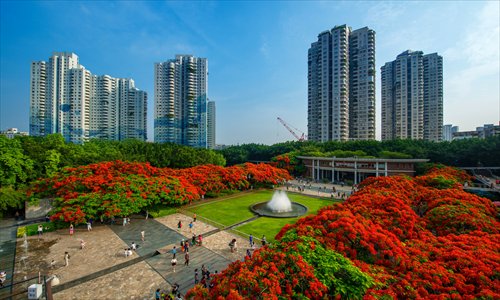Tech firms seen leaving Shenzhen
High costs driving manufacturers inland or overseas: experts

A view of Ecological Square in Shenzhen Overseas Chinese Town Photo: IC
Shenzhen in South China's Guangdong Province has long been known as an electronics manufacturing hub, but for some Chinese tech companies it appears to be losing its attraction.
Since the beginning of 2015, many small and medium-sized manufacturers in Shenzhen have started moving their production facilities to other regions to seek lower production costs, Zeng Feiqiang, vice president of Shenzhen Langmei Technology Co, told the Global Times on Tuesday.
The trend is spreading to large-scale manufacturers as well, according to media reports. China Business News (CBN) reported on Monday that Huawei Technologies Co, a leading domestic telecommunications equipment maker, will probably shift its focus from Shenzhen to Dongguan, another manufacturing hub in Guangdong, which is 64 kilometers away from Shenzhen.
Huawei has reportedly been moving most of its mobile device production and export operations to a division registered in Dongguan since 2014.
The local government of Longgang district in Shenzhen, where Huawei is headquartered, has expressed concerns over the company's potential exodus, CBN reported, citing an official local government report. Huawei contributed more than 47 percent of Longgang's overall industrial output in the first two months of 2016, the CBN report said.
Huawei refused to comment when contacted by the Global Times on Tuesday, but the company was quoted by the Shenzhen Internet Information Office as saying in an official Weibo post on Monday that it had no intention of moving the headquarters out of Shenzhen.
As well as Shenzhen, East China's Zhejiang Province and Shanghai are confronting the same issue, with various plants relocating to nearby regions or further inland, analysts said.
This is a natural choice, as the labor costs are rising in China's eastern coastal regions, Wang Danqing, a partner at Beijing-based ACME consultancy, told the Global Times on Tuesday.
Having to pay higher wages hurts companies' profits, Zeng said. "The average salary paid for an ordinary worker in Shenzhen is now up to 5,000 yuan ($763) per month, up from 3,000 yuan last year."
Both Zeng and Wang said the red-hot real estate market in big cities is another factor.
In Shenzhen, for instance, local house prices jumped 63.4 percent in April year-on-year, the biggest rise among major cities in China, according to data from the National Bureau of Statistics.
Ren Zhengfei, the founder and CEO of Huawei, said in a recent interview with Xinhua News Agency that Shenzhen has too many real estate development projects and that the city lacks a sufficient amount of industrial land that is needed for the development of the manufacturing sector.
"Increasing production costs make it hard for big cities to maintain their attraction for manufacturers. The services industry should be the engine for future development in these cites," said Wang.
Moving inland
Foxconn Technology Co moved some of its production lines from Shenzhen to Southwest China's Chongqing, the country's only inland municipality, in 2009.
As well as the lower labor costs in inland areas, the local governments also offer favorable policies such as tax cuts to appeal to manufacturers.
This is in line with guidelines issued by the State Council in 2010 to encourage businesses to relocate their operations to China's inland and western areas.
Against this backdrop, Chongqing saw its GDP grow by 11 percent in 2015, 4.1 percentage points above the national average. The city now manufactures about 40 percent of the world's laptops and 30 percent of China's motorcycles, according to media reports.
However, Wang said that central government efforts to get firms to move inland have not been effective enough so far, and improvements are needed.
"Both eastern and central regions are competing for large-scale high-end manufacturing and offer little support for labor-intensive manufacturing, leading a large wave of processing exporters to move to countries in Southeast Asia," he said.
Shenzhen-based Langmei, which produces and exports smart tablets, did not bet on inland China. Having left just its R&D team in Shenzhen, Langmei has transferred its manufacturing operations to India, where the average salary is only $100 per month.
Governments in other Southeast Asian countries usually offer assistance to manufacturers, even small-scale ones, such as subsidies for setting up plants and tariff refunds, which the Chinese governments does not offer, said Zeng.
Processing trade exports, which have done much to boost China's foreign trade, fell 8.2 percent year-on-year in April, declining for the 14th straight month, according to the Ministry of Commerce.